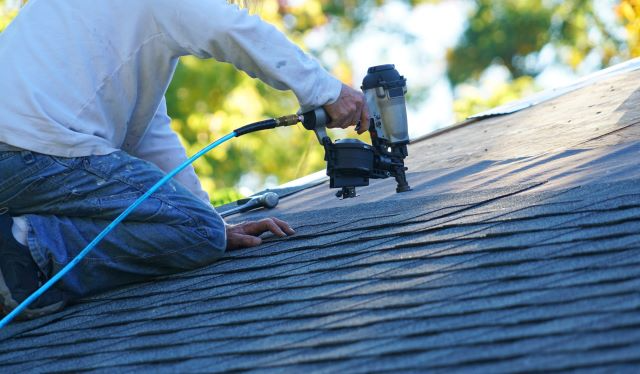The calendar says spring is the perfect time for roof installation in Quincy, IL, but Mother Nature rarely reads construction schedules. One week brings perfect 70-degree weather with gentle breezes, and the next delivers thunderstorms that halt all outdoor work for days. This weather roulette affects more than just project timelines—it shapes every decision homeowners make about protecting their most valuable investment.
Quincy homeowners face a unique challenge that contractors from neighboring regions often underestimate. The Mississippi River valley creates microclimates that can shift dramatically within hours, turning ideal installation conditions into scenarios that demand immediate protective measures. Understanding these patterns isn’t just helpful for planning—it’s essential for ensuring your new roof performs exactly as designed for decades to come.
The difference between a successful roof installation and years of problems often comes down to timing, preparation, and working with contractors who understand local conditions. Companies like Surge Exteriors have learned to work with Quincy’s unpredictable weather rather than against it, developing strategies that protect both ongoing projects and homeowner investments regardless of what the sky decides to deliver.
Spring Installation Challenges That Catch Homeowners Off Guard
March through May should represent prime roofing season, but Quincy’s spring weather creates complications that inexperienced contractors struggle to navigate. Severe thunderstorms can appear with little warning, transforming partially completed installations into emergencies that require immediate attention.
The real challenge isn’t just rain—it’s the rapid temperature fluctuations that affect how roofing materials perform during installation. Shingles that install perfectly at 75 degrees behave differently when afternoon temperatures drop to 45 degrees with approaching storm fronts. Professional installers understand these material behaviors and adjust their techniques accordingly.
Wind presents another variable that significantly impacts project planning. Quincy’s location along the Mississippi River creates wind patterns that can make roofing work dangerous even when conditions appear calm from ground level. Experienced contractors monitor weather forecasts constantly and know when to halt work before conditions become hazardous.
Hail damage during installation season creates particularly frustrating scenarios. Projects that seemed to progress smoothly can suffer setbacks when spring storms deliver golf-ball-sized hail that damages newly installed materials. Quality contractors build contingency plans into their project timelines to address these possibilities without leaving homes vulnerable.
Summer Heat and Its Impact on Installation Quality
July and August bring different challenges that affect both worker safety and material performance. Quincy’s summer temperatures regularly reach the 90s with humidity levels that make roof surfaces dangerously hot for installation crews.
Asphalt shingles become extremely pliable in high heat, making them susceptible to damage from foot traffic during installation. Walking on hot shingles can leave permanent impressions or cause granule loss that affects long-term performance. Professional installers schedule work during cooler morning hours and use specialized techniques to minimize material damage.
The heat also affects adhesive strips on shingles, causing them to activate prematurely and create installation difficulties. Experienced crews understand how to handle materials in extreme heat while ensuring proper bonding that will withstand future weather challenges.
Installation timing becomes critical during heat waves. Starting work too late in the morning can create conditions where materials become too hot to handle safely, forcing delays that extend project timelines. Surge Exteriors and other professional contractors adjust schedules to work around these temperature challenges while maintaining quality standards.
Fall Installation Benefits and Hidden Complications
September through November offer some of the most favorable conditions for roof installation in Quincy, IL, but seasonal factors create unique considerations that affect project planning.
Cooler temperatures make working conditions more comfortable while allowing roofing materials to perform optimally during installation. Shingles remain flexible enough for proper handling without becoming overly soft from heat exposure. Wind conditions typically stabilize compared to spring patterns, creating safer working environments for installation crews.
However, fall brings its timeline pressures. Homeowners often rush to complete projects before winter, creating scheduling bottlenecks that can compromise quality if contractors take on more work than they can properly handle. Daylight hours shrink steadily, reducing productive work time and requiring careful project management to maintain progress.
Falling leaves create cleanup challenges that add time and complexity to installation projects. Gutters must be cleared repeatedly to prevent drainage issues, and leaf accumulation on roof surfaces can create slippery conditions that pose safety risks for work crews.
Winter Emergency Installations and Special Considerations
While winter represents the most challenging season for roof installation, emergencies sometimes demand immediate action regardless of weather conditions. Ice dam damage, storm-related failures, and sudden leaks can’t wait for spring when they threaten structural integrity or family safety.
Winter installations require specialized techniques and materials that many contractors lack experience with. Cold temperatures affect how shingles seal and bond, requiring modified installation procedures to ensure proper performance. Snow and ice removal becomes necessary before work can begin, adding complexity and cost to emergency projects.
Professional contractors like Surge Exteriors maintain capabilities for emergency winter work while honestly assessing when conditions make quality installation impossible. They understand the difference between repairs that can protect homes through winter and full installations that should wait for favorable weather.
Heating equipment may be necessary to warm materials and work surfaces, ensuring proper adhesion in cold conditions. These specialized requirements separate experienced local contractors from those who lack the equipment and expertise for challenging winter installations.
How Local Expertise Makes the Difference
Understanding Quincy’s weather patterns requires years of local experience that can’t be gained from textbooks or regional training programs. Contractors who focus on Illinois installations develop instincts about weather changes that help them protect projects and homeowner investments.
Surge Exteriors has built its reputation by learning from every challenging installation season. They know which weather forecasts to trust, how different materials behave in local conditions, and when project delays serve homeowners’ best interests rather than rushing to meet arbitrary deadlines.
Local expertise extends beyond weather awareness to understanding how Quincy’s unique environmental factors affect long-term roof performance. Mississippi River humidity, seasonal temperature swings, and prevailing wind patterns all influence material selection and installation techniques that determine how well roofs perform over their expected lifespan.
Building relationships with local suppliers ensures access to materials that perform best in regional conditions while maintaining inventory levels that support project timelines even during busy seasons.
Planning Your Installation for Maximum Success
Successful roof installation in Quincy, IL, begins with realistic timeline expectations that account for weather delays and seasonal factors beyond anyone’s control. Homeowners who understand these variables make better decisions about project timing and contractor selection.
Start planning installations well before emergencies develop. Roofs showing signs of deterioration perform better when replacement occurs during favorable weather rather than after failure creates urgent timeline pressures.
Consider seasonal advantages when scheduling projects. Fall installations often provide optimal conditions, but spring scheduling allows more flexibility for weather-related delays. Summer installations can work well for emergency situations despite heat challenges.
Work with contractors who demonstrate local expertise and maintain realistic schedules that prioritize quality over speed. Companies that promise unrealistic completion times often cut corners or work in conditions that compromise long-term performance.
Protecting Your Investment Through Every Season
Roof Installation in Quincy, IL represents one of the largest investments homeowners make in property protection and value preservation. Understanding how Quincy’s unique weather patterns affect this investment helps you make informed decisions about timing, materials, and contractor selection.
Professional installation teams prepare for weather challenges by monitoring forecasts, maintaining protective equipment, and developing contingency plans that keep projects moving safely forward. They understand that temporary delays often prevent permanent problems that could affect your roof’s performance for years.
The unpredictable nature of Quincy’s installation season doesn’t have to create uncertainty about your roofing project. Working with experienced local contractors like Surge Exteriors ensures your installation receives the expertise and attention necessary for long-term success, regardless of what weather challenges arise during the process.

